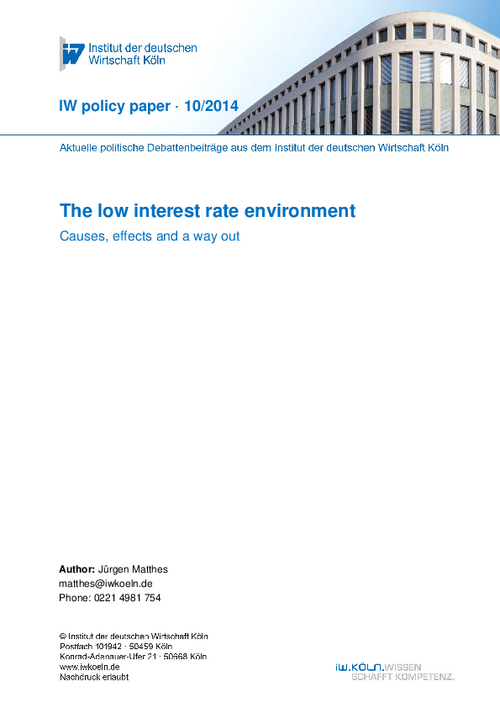Causes, effects and a way out

The low interest rate environment
IW policy paper

Causes, effects and a way out
The very expansive and unconventional monetary policy of the ECB reduced the tensions of the Euro debt crisis at the price of persistently very low interest rates. While the ECB was right to act at the peak of the crisis, the risks of the low-interest rate environment become increasingly obvious. Private savings suffer from very low yields, which is particularly detrimental for long-term retirement savings. Moreover, financial stability risks could arise, as ultra-low interest rates can cause a search for yield among investors. Banks and life insurance companies are exposed to reduced interest profits respectively lower yields. While life insurance companies can cope with a shorter period of low interest rates, a longer period, however, poses challenges, as contracts with guaranteed interest rates have to be served.
Therefore, it is a positive sign that the economic conditions for an interest rate turnaround have improved significantly since 2012 and are expected to improve further. Economic activity is clearly on an upward trend which is expected to continue despite current uncertainties. Significant structural reforms have been implemented in most stressed Euro countries which will most likely increase growth potentials soon (as already appears to be the case in Spain). Due to a stronger economy fears of deflation should only be a temporary phenomenon. Stress indicators and fundamentals in the banking sector have also improved on the back of (late but eventually decisive) policy measures and will continue to do so in the course of the ECB’s pending stress test. Public and private indebtedness should be manageable in an environment where a sustainable moderate economic growth and more normal inflation are present. These are the conditions which characterize the baseline scenario assumed here.
Despite remaining uncertainties, e.g. geopolitical risks or a lack of reform implementation, in our baseline scenario an interest rate turnaround appears possible in the second half of 2015. As an exit from the long low interest rate period poses significant challenges to financial markets, the ECB should institute a smooth interest rate turnaround and communicate its preconditions very actively. More concretely, the ECB should raise interest rates initially only in very small monthly steps to allow financial actors to better adapt to the changing interest rate environment.

Jürgen Matthes: The low interest rate environment – Causes, effects and a way out
IW policy paper


33. Finanzmarkt Round-Table: De-Industrialisierung – Gefahr für den Finanz- und Wirtschaftsstandort Deutschland?
Das Institut der deutschen Wirtschaft, die DekaBank und die Börsen-Zeitung laden Sie zum Finanzmarkt Round-Table am Montag, den 29. April 2024 von 10:30 bis 12:30 Uhr ein. Der Round-Table findet als Online-Veranstaltung statt.
IW
Tarifverhandlungen 2024: Es droht eine höhere Inflation
Im Frühjahr stehen weitere Tarifverhandlungen in der Chemie- und Baubranche sowie dem Bankwesen an. Beharren die Gewerkschaften auf ihre hohen Forderungen, könnte dies auch die Inflation wieder hochtreiben. Davor warnt eine neue Studie des Instituts der ...
IW